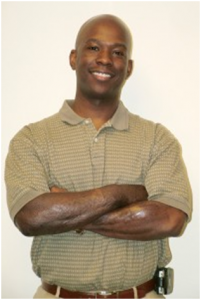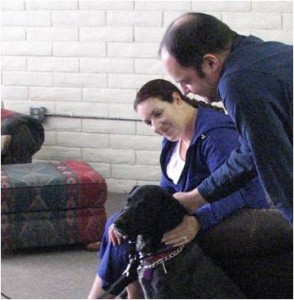By Diana Hume, AW2 Reserve Spouse and Guest Blogger

Diana Hume offers resources to help others understand the impact of living with PTSD.
Editor’s Note: Diana Hume is a feature blogger for AW2 and shares her experiences as the wife of a severely wounded reservist. The expressed comments and views of guest bloggers do not reflect the views of WTC or the United States Army.
The effects of post-traumatic stress disorder (PTSD) are just beginning to be understood. During my time at Walter Reed Army Medical Center, I noticed that those with visible wounds were treated as rock stars while those with invisible wounds silently carried on without the attention the others received. These Soldiers kept trying to be the Soldier they once were pre-deployment. I found out the hard way that there is no prosthetic for invisible wounds like PTSD.
PTSD is complex because it doesn’t take the form of a body disfigurement or a lost limb. I see my husband walking, talking, and trying to function every day. But for those who live with him, they are well aware that he’s actually taking on the weight of the universe. The pain is visible in his face, his motions, and self-controlled isolation.
Part of me feels that PTSD comes off as a buzz term in news segments. I wonder how many people actually know about the condition. How many Americans can say they understand PTSD? More importantly how many people understand what PTSD means to not just Soldiers but for their caretakers and Families?
When I first faced PTSD, I tried so hard to grasp what this injury meant to my husband. I did what most Army spouses did in this situation. I began researching and reading all I could find on the subject, but could not quench my thirst for true understanding. Although I found some short-term help for caretakers, I needed something that could help me in the long run. Here are a few good places to start:
Wounded warriors with PTSD have no idea who they are. They hurt. They climb into black holes and rarely come out. PTSD is anger that can easily become rage and when self-medicating becomes the norm, along with avoidance, the true damage takes the form of broken relationships, lost jobs, incarceration, and in some extreme cases, suicide. Because it is not visible to the eye, it is glazed over and misunderstood.
Those with PTSD and their caretakers struggle with the peaks and valleys that come with PTSD. We are told to learn to recognize the triggers, but for many of us, the triggers are still a mystery and we never know when the eruption will occur. The abrupt eruptions of anger suddenly become part of our daily life and reality. It becomes so intangible that wrapping our arms around it to alleviate the situation hurts more than it helps. It hurts even more that the public doesn’t seem to understand how PTSD has, and continues to, plagued my Family.
One example that highlights the public’s perception of PTSD was at Walter Reed Medical Center in DC when Oprah Winfrey filmed a segment on the visible wounds of war. While at the physical therapy unit, she took a moment to shake the hands of the wounded warriors. However, when my wounded warrior had a moment to shake her hand, she turned her back to him because she did not see any visible wounds and thought he was any other healthy Soldier. Needless to say, this did not sit well with me. The moment I had the opportunity, I walked up to her, looked her in the eye and told her about the men and women who were standing right in front of her and who are just as wounded as those with missing arms and legs. Although their injuries are invisible, they are suffering just as much as the men and women she featured on her segment.
To this day, I am not sure how she received my words, but I do know she eventually took action to get my point across to her audience. Just a few weeks later, she aired the segment on television and I realized that she included a journalist who had been in Iraq and ultimately was diagnosed with PTSD. She also told her audience about our interaction, telling her viewers that an Army spouse informed her about the invisible wounds of war that caused just as much suffering to wounded warriors as visible wounds cause. At that point, I knew that I at least was able to get Oprah to start a conversation.
My experience with Oprah was the first of many experiences when people asked me if my husband is wounded. After saying yes, they always follow-up with, “but what is wrong with him?” For Soldiers with invisible wounds, this can be a defeating comment that stays with them and makes them feel like they are the ones who need to get over it.
My point with this blog is to inspire a discussion about what PTSD really is and what is needed to help those living with it overcome this challenge. PTSD is never healed and it impacts the lives of not just the Soldiers who are invisibly disfigured, but those who love them. Although hard data on PTSD’s impact on America is not yet available, I believe you can measure PTSD’s impact in the number of divorces, suicides, and extended Family therapy that people undergo.
Wounded warriors suffering from PTSD need the same level of support that Soldiers with visible wounds receive. That is why it is important to continue communicating about PTSD and how people can manage the condition. Don’t get me wrong, there are many Americans who truly care. They are listening. However, it is up to Soldiers, Veterans, and Families who are combating PTSD to inform the rest of America on how to take action. I believe that by getting the word out, America’s take on PTSD will move in a positive direction.
Caretakers can either choose to ignore PTSD or choose to improve their wounded warrior’s life. I made a choice a long time ago to make an improvement. For those in the AW2 community, I hope I have inspired you to speak up for those who have PTSD. We have to accept PTSD for what it is and with this approach we can do something that will help wounded warriors and their Families.










